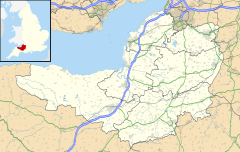Croscombe
| Croscombe | |
|---|---|
 The course of the River Sheppey has been substantially 'managed' on its way through Croscombe, as this weir area demonstrates. The Sheppey was the main power source for many of the mills which operated in Croscombe in the 18th and 19th centuries. |
|
| Croscombe shown within Somerset | |
| Population | 603 (2011) |
| OS grid reference | ST595445 |
| District | |
| Shire county | |
| Region | |
| Country | England |
| Sovereign state | United Kingdom |
| Post town | WELLS |
| Postcode district | BA5 |
| Dialling code | 01749 |
| Police | Avon and Somerset |
| Fire | Devon and Somerset |
| Ambulance | South Western |
| EU Parliament | South West England |
| UK Parliament | |
Croscombe is a village and civil parish 2 miles (3 km) west of Shepton Mallet and 4 miles (6 km) from Wells, in the Mendip district of Somerset, England. It is situated on the A371 road in the valley of the River Sheppey.
Croscombe has a village hall, a shop, a public house, a Church, a chapel and a school.
North-east of the village and within the parish boundary is Maesbury Castle, an Iron Age hill fort.
It was first recorded in 706 when King Ine of Wessex referred to the village as Correges Cumb. The parish of Croscombe was part of the Whitstone Hundred. Croscombe emerged in the 16th and 17th centuries with a boom in the wool trade. During this period many houses, cottages and hostelries were built and the church was reconstructed.
During the Industrial Revolution, silk, mining, quarrying and milling replaced the wool trade. In 1848 the River Sheppey powered two mills for grinding corn, one for winding silk, and another used as a stocking manufactory.
The Old Manor was built around 1460–89 as a rectorial manor house for Hugh Sugar, the Treasurer of Wells Cathedral. It was altered in the 16th and 18th centuries, and in the 20th century by the Landmark Trust. It has been designated as a Grade I listed building.
...
Wikipedia

